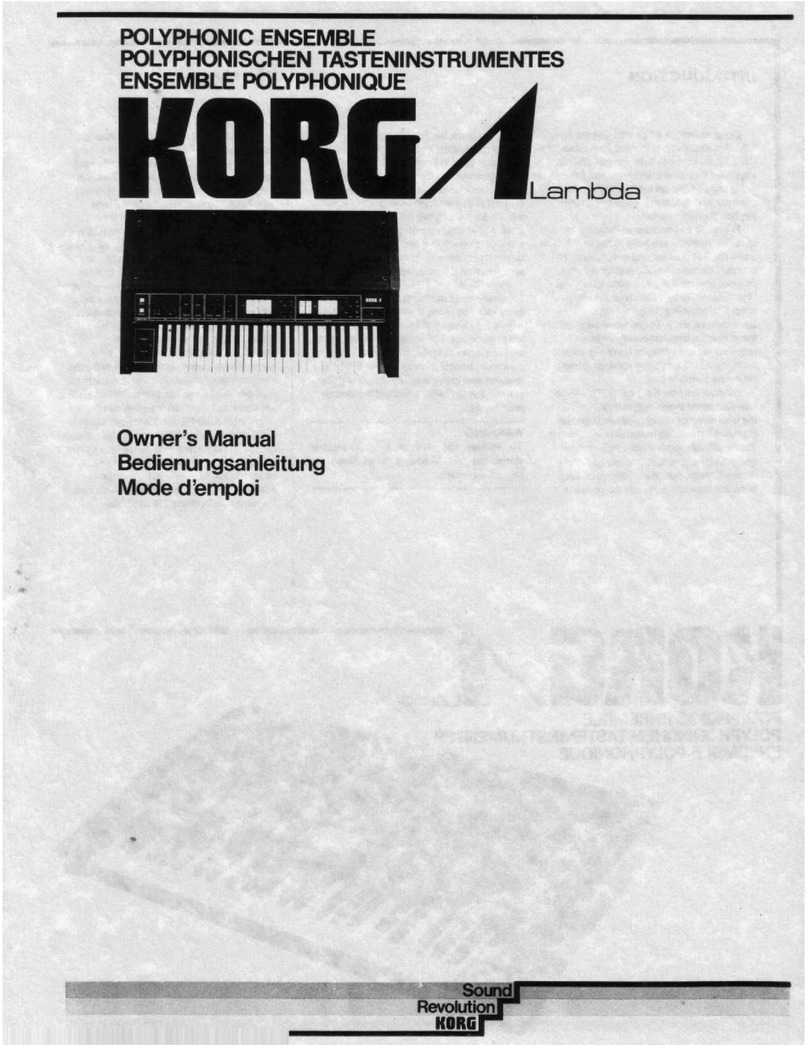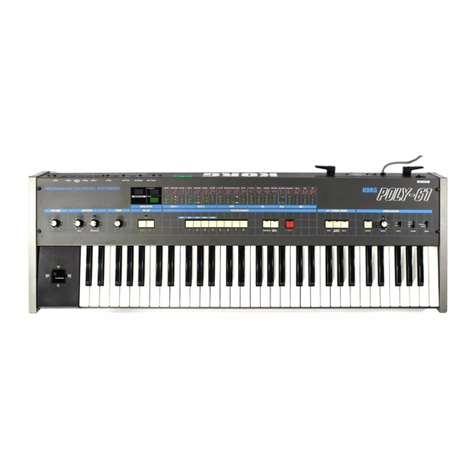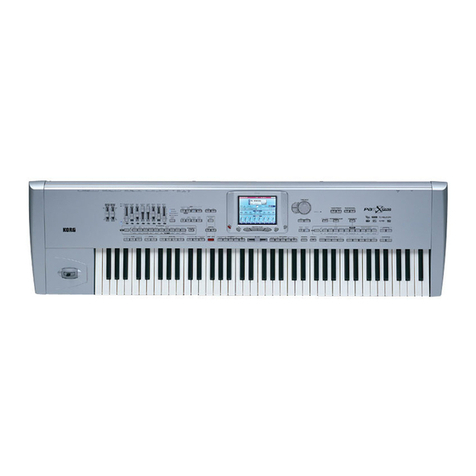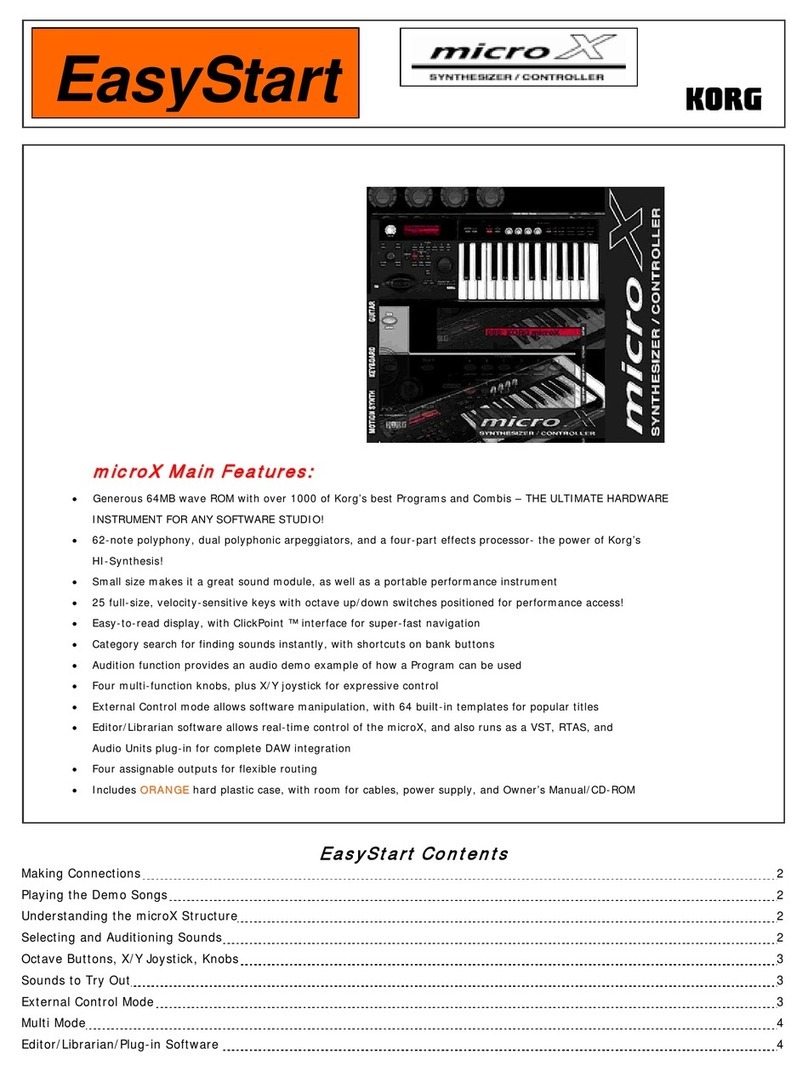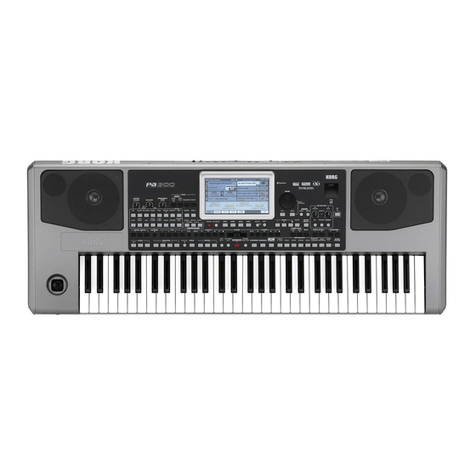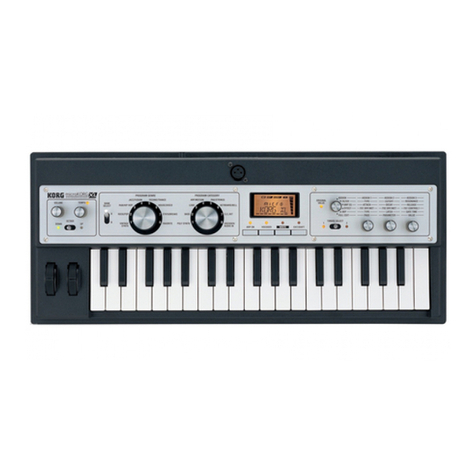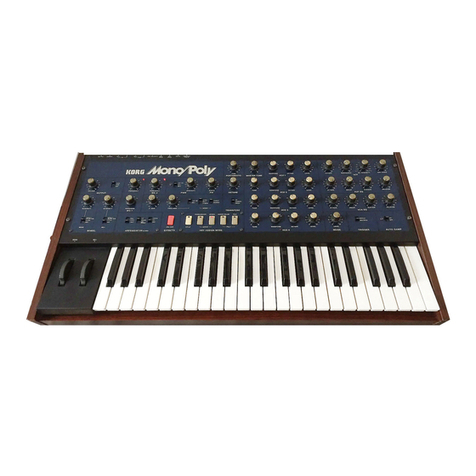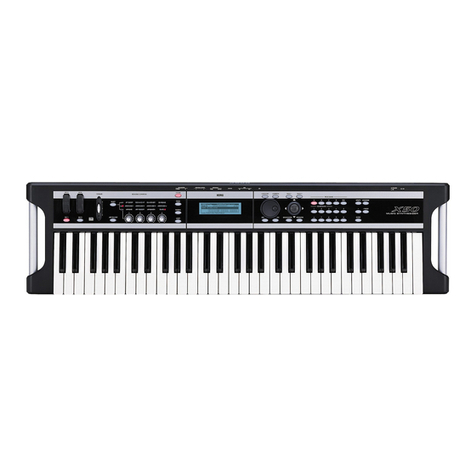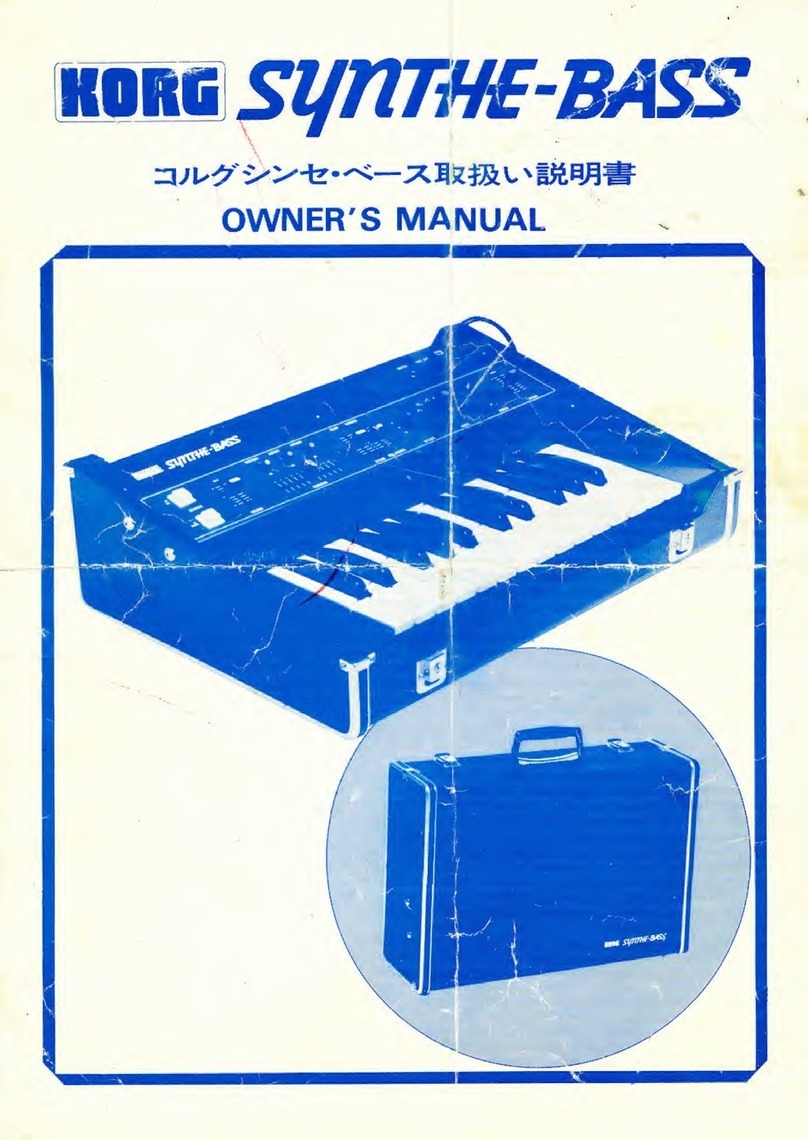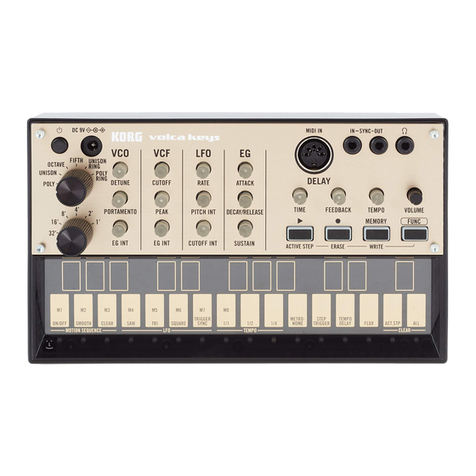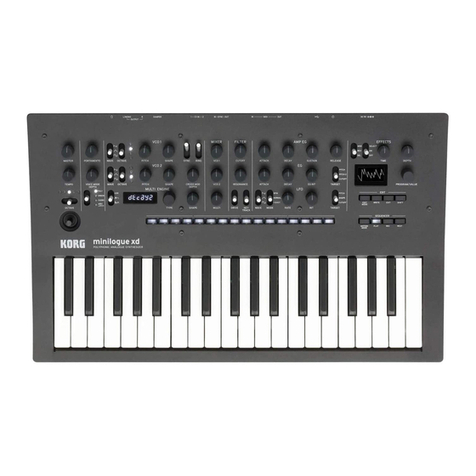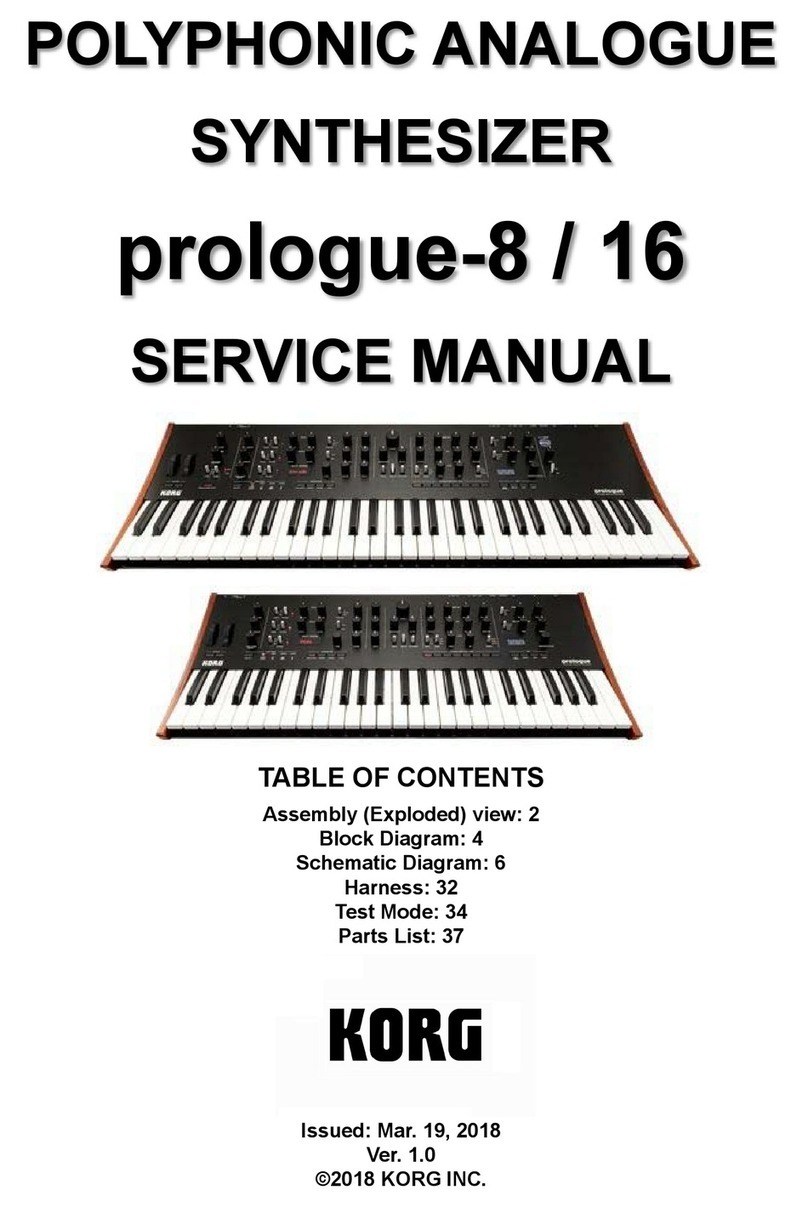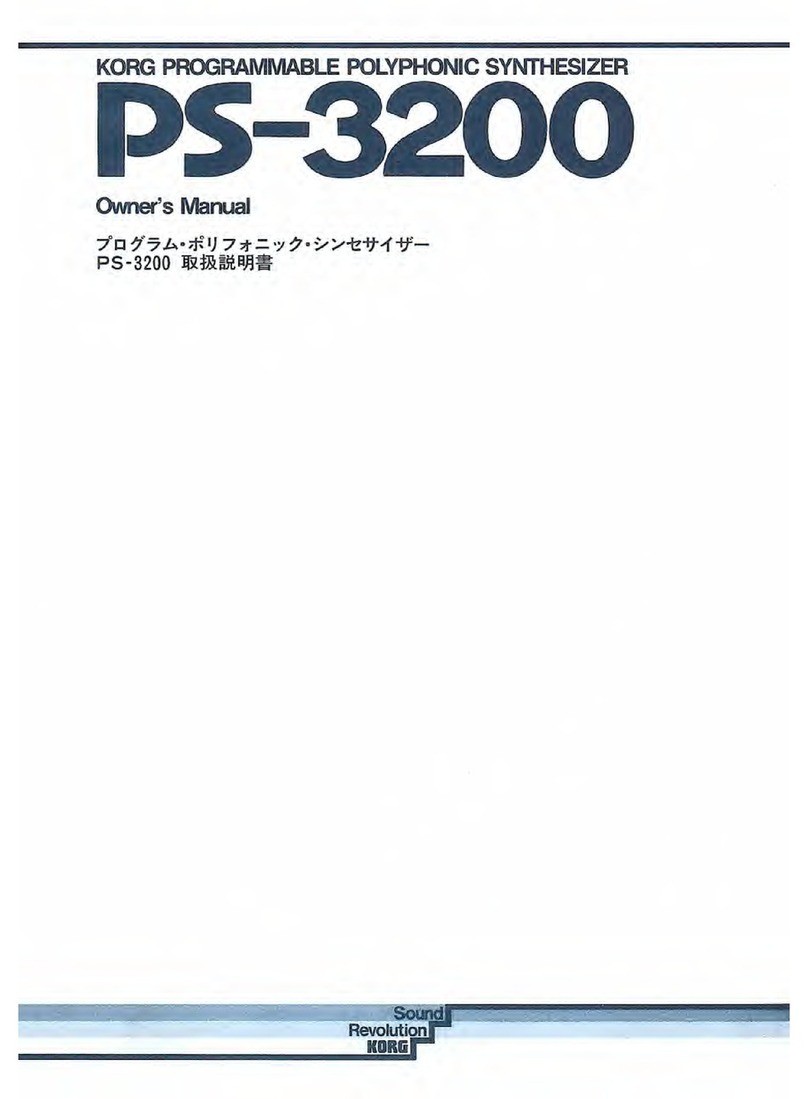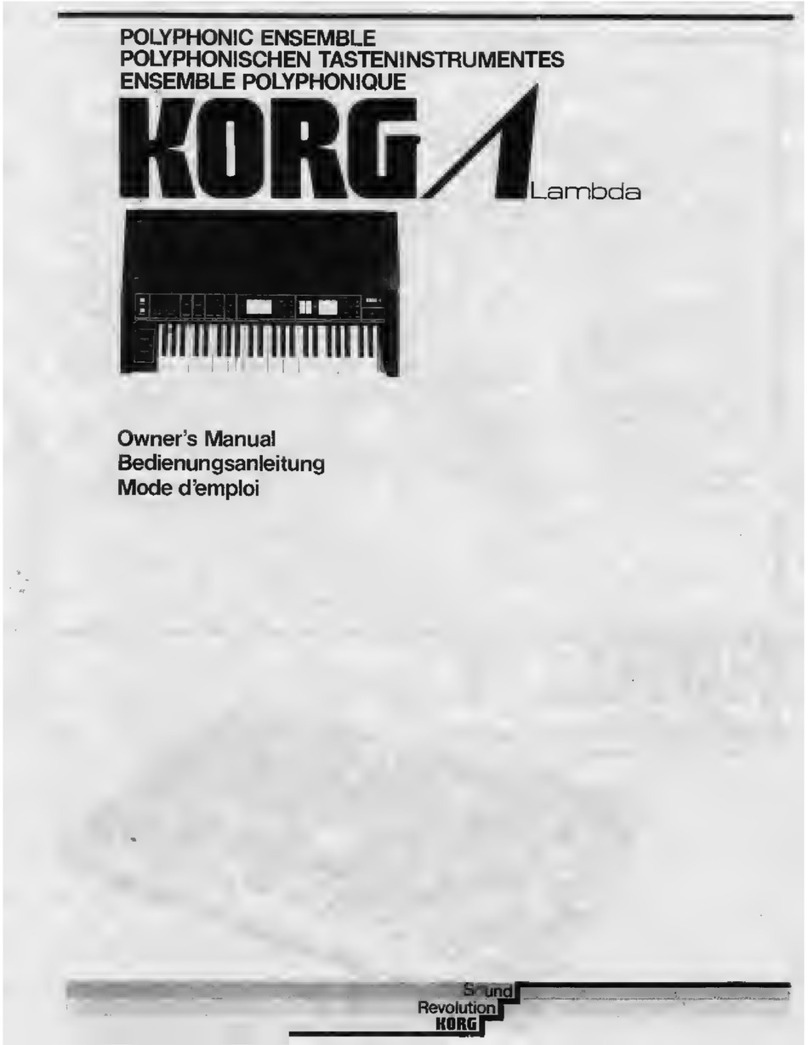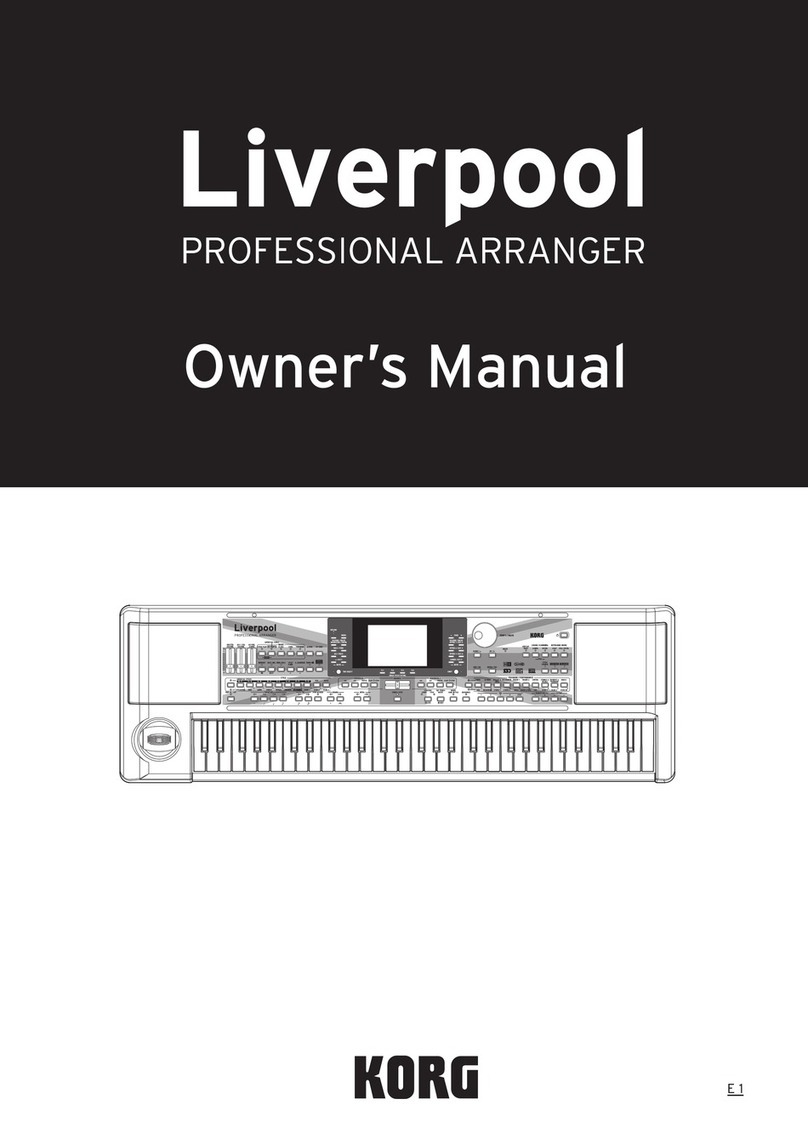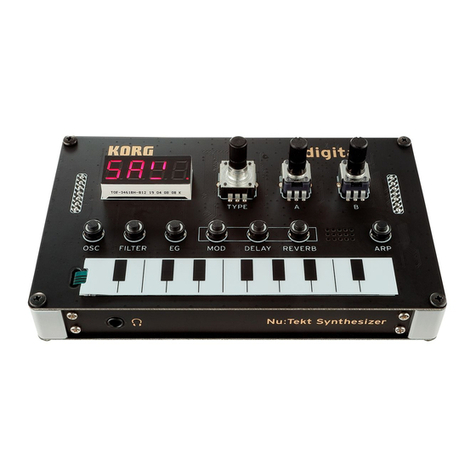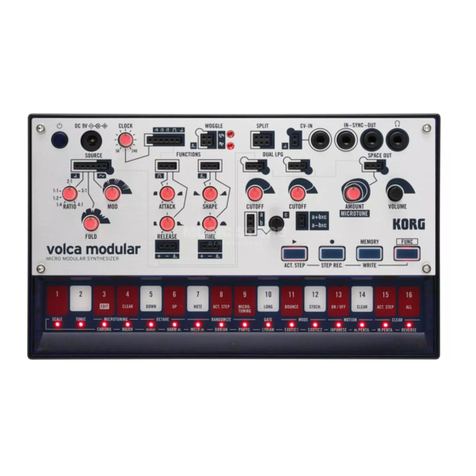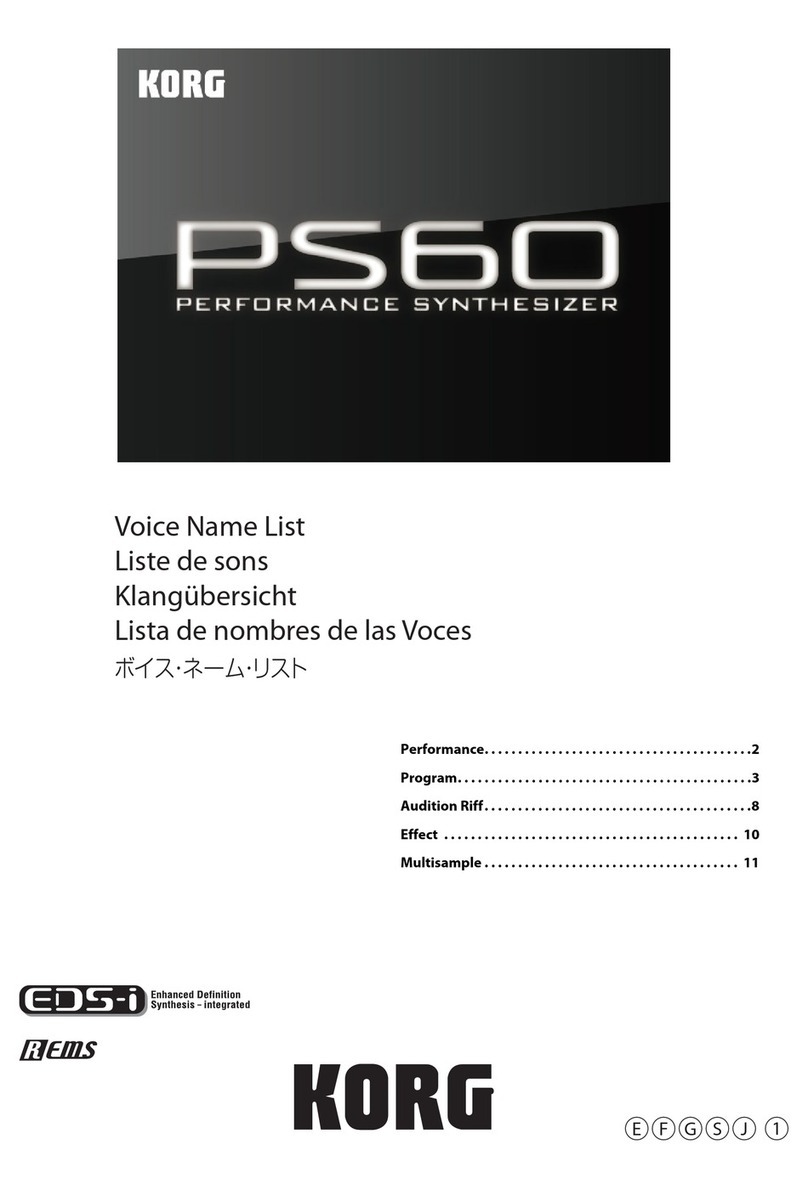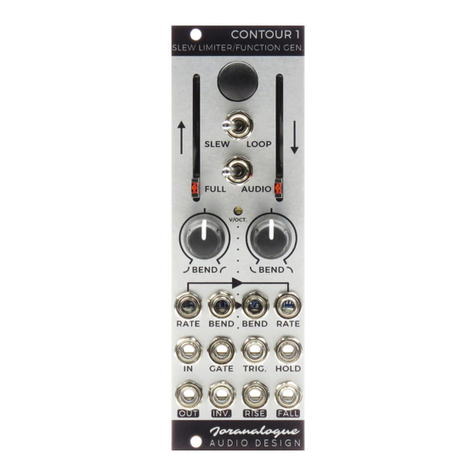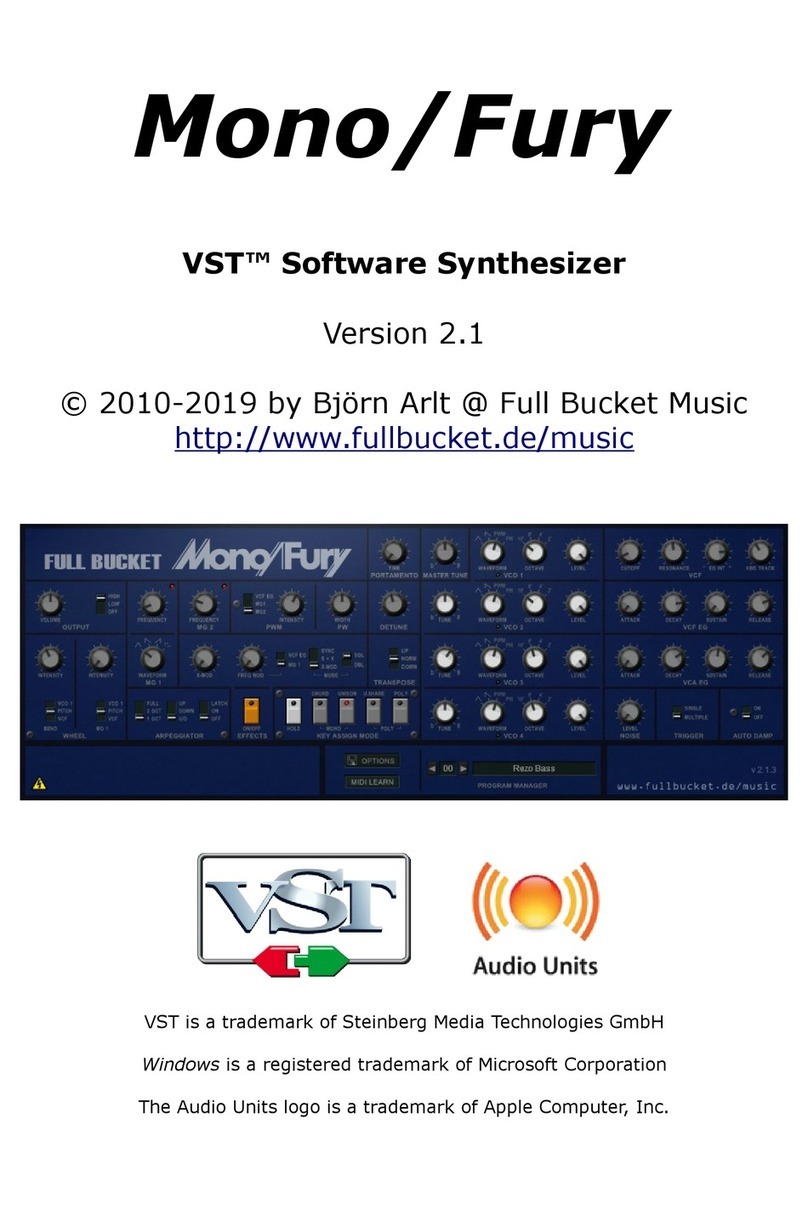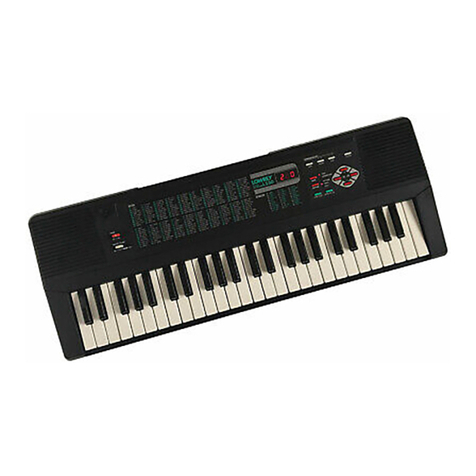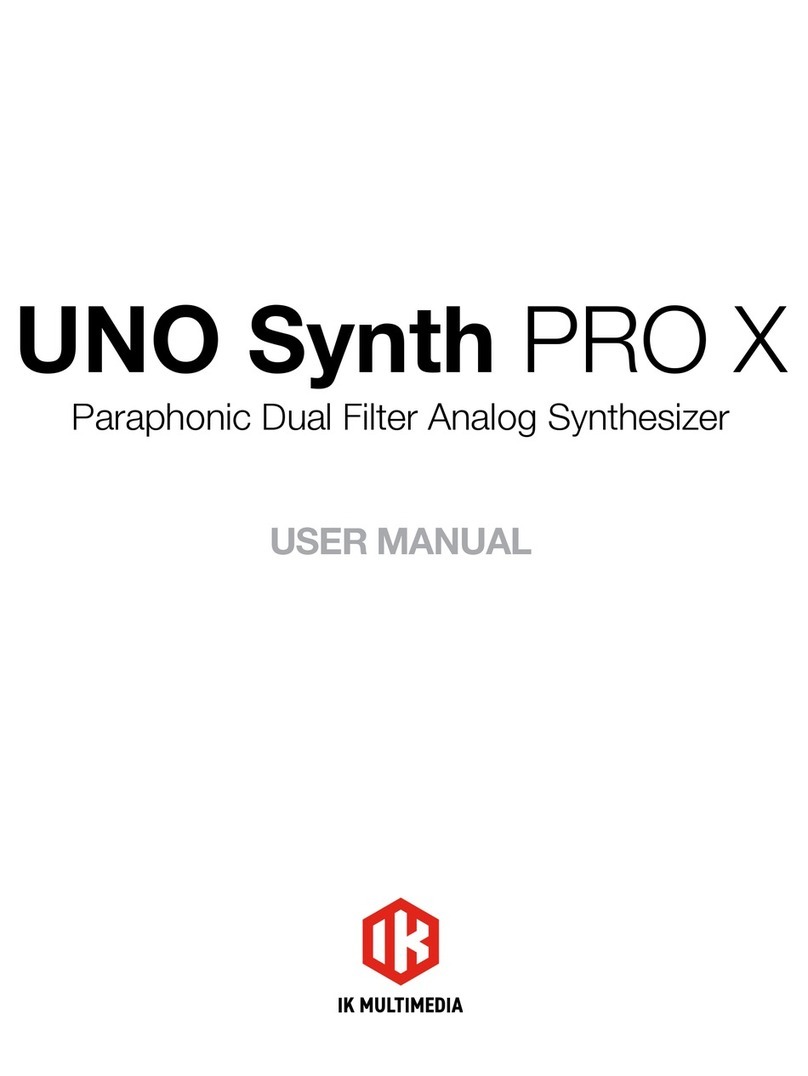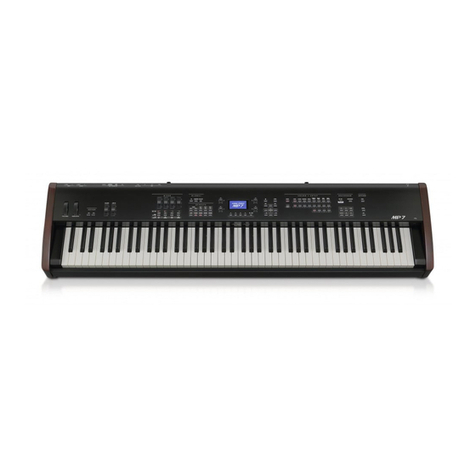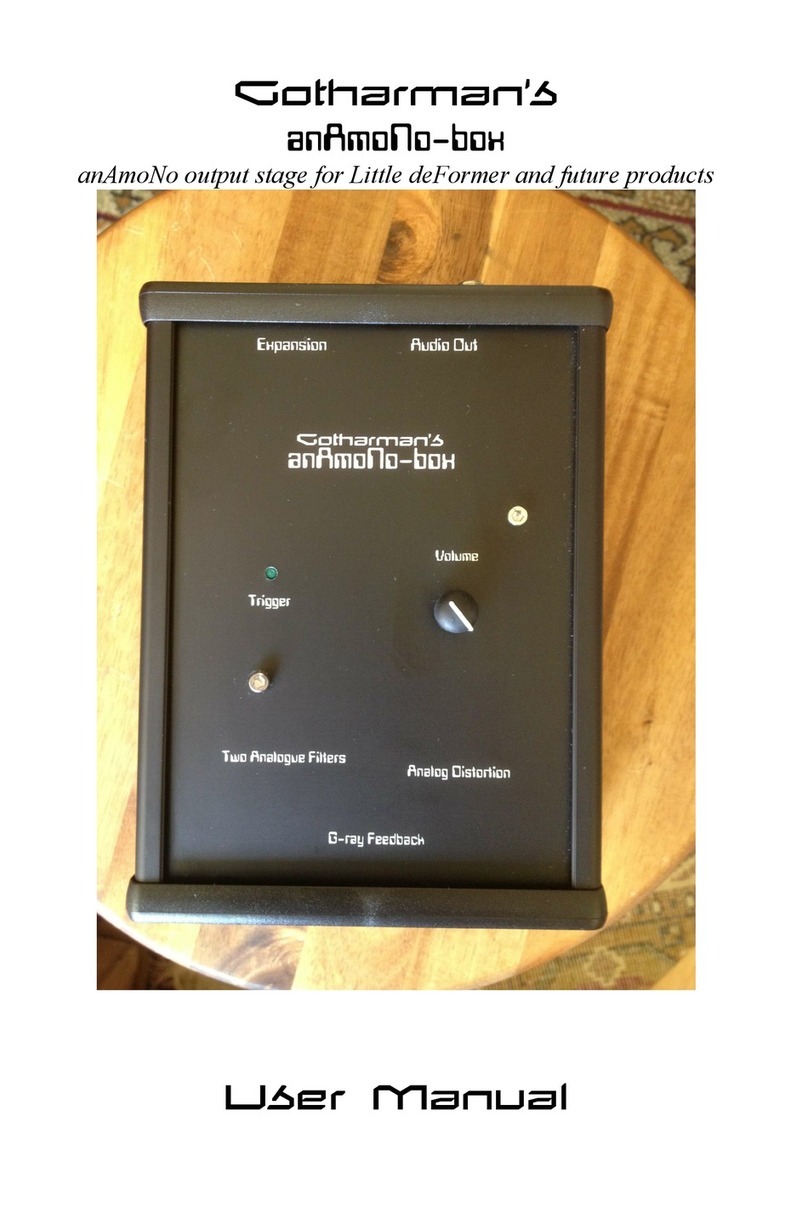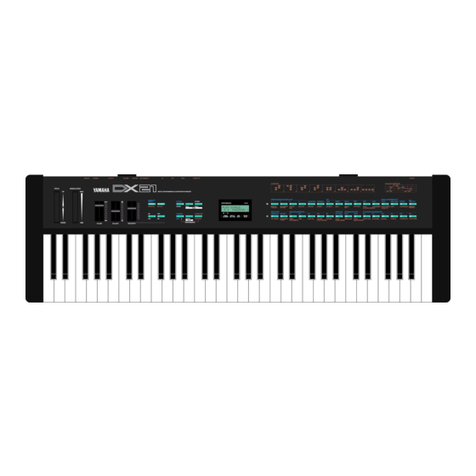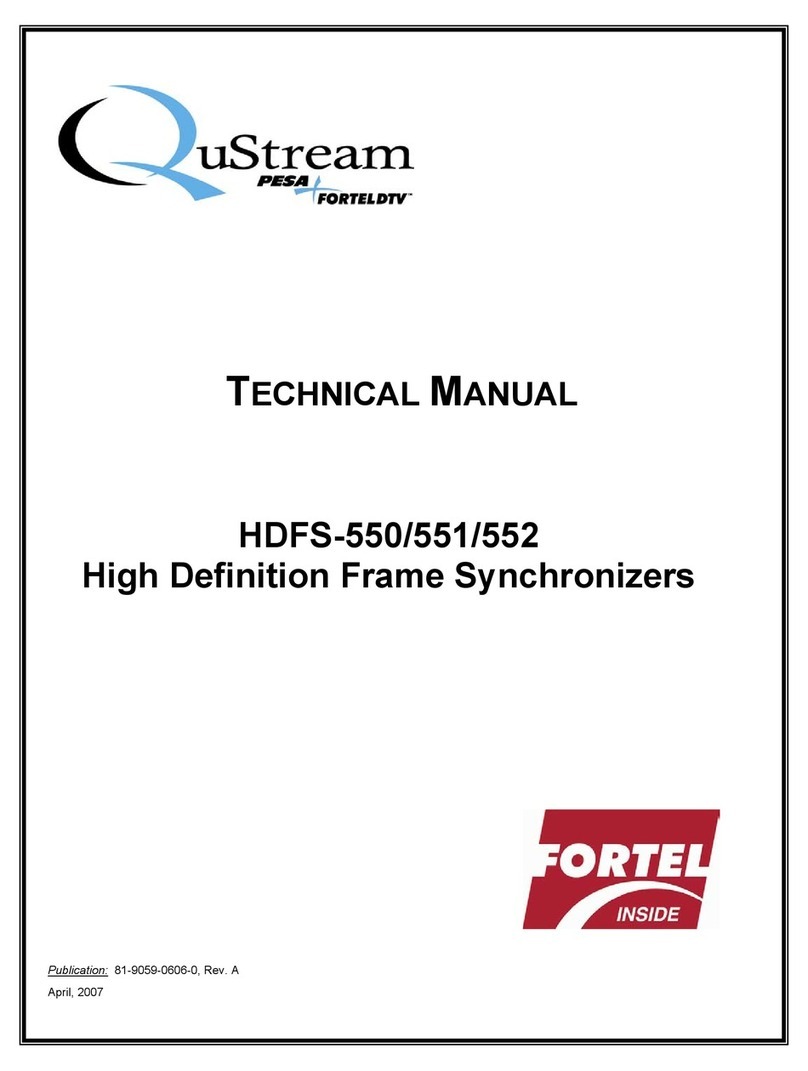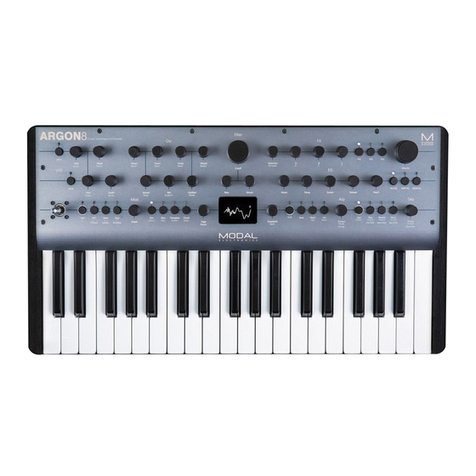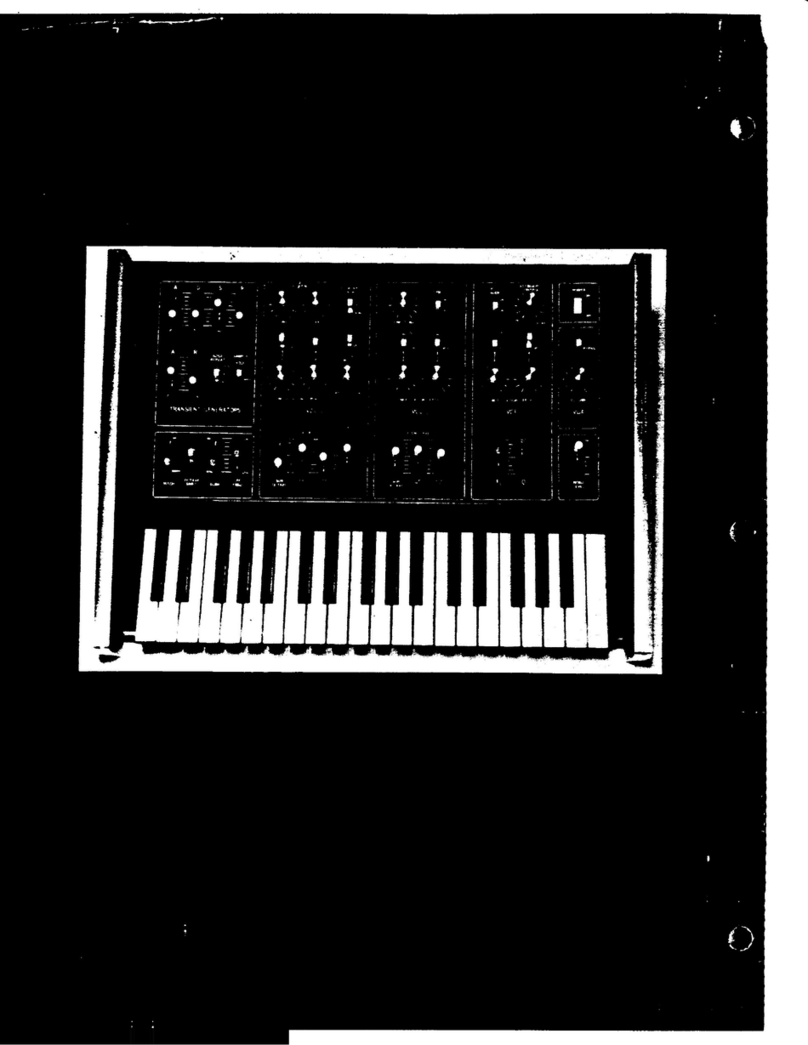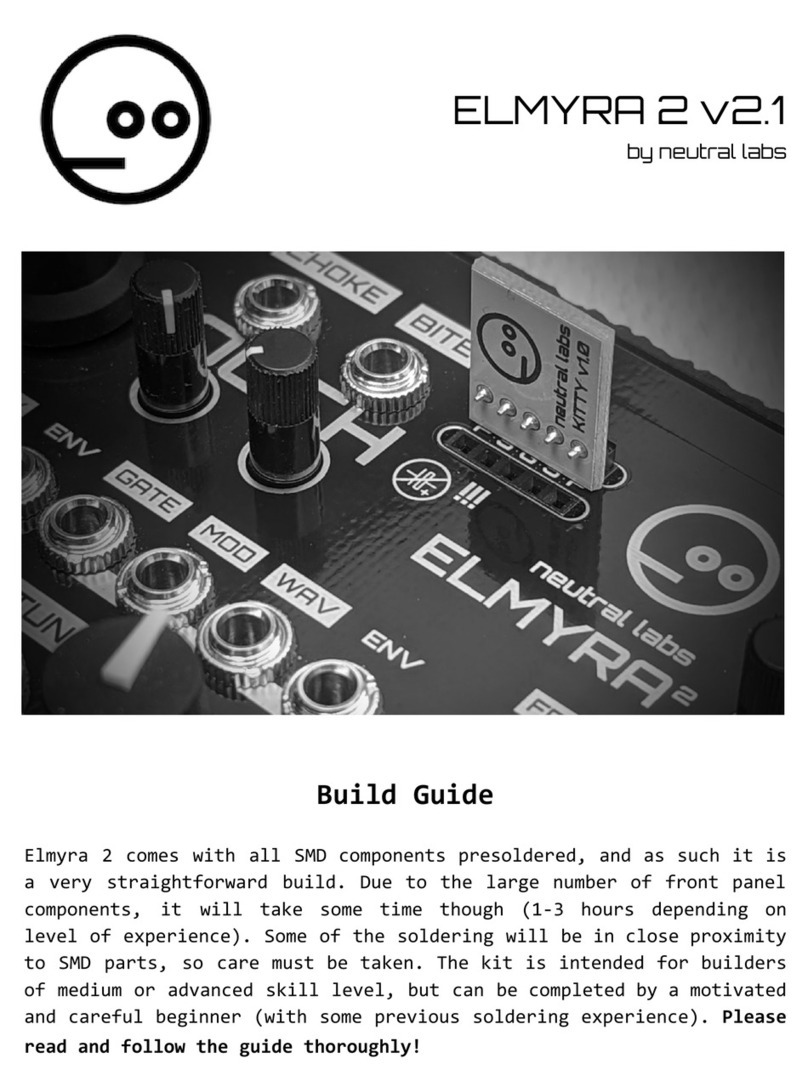
Precautions
Location
Using the unit in the following locations can result in a malfunction.
• In direct sunlight
• Locations of extreme temperature or humidity
• Excessively dusty or dirty locations
• Locations of excessive vibration
• Close to magnetic elds
Power supply
Please connect the designated AC adapter to an AC outlet of the cor-
rect voltage. Do not connect it to an AC outlet of voltage other than
that for which your unit is intended.
Interference with other electrical devices
Radios and televisions placed nearby may experience reception
interference. Operate this unit at a suitable distance from radios and
televisions.
Handling
To avoid breakage, do not apply excessive force to the switches or
controls.
Care
If the exterior becomes dirty, wipe it with a clean, dry cloth. Do not
use liquid cleaners such as benzene or thinner, or cleaning com-
pounds or ammable polishes.
Keep this manual
After reading this manual, please keep it for later reference.
Keeping foreign matter out of your equipment
Never set any container with liquid in it near this equipment. If liquid
gets into the equipment, it could cause a breakdown, re, or electrical
shock.
Be careful not to let metal objects get into the equipment. If some-
thing does slip into the equipment, unplug the AC adapter from the
wall outlet. Then contact your nearest Korg dealer or the store where
the equipment was purchased.
THE FCC REGULATION WARNING (for USA)
NOTE: This equipment has been tested and found to comply with
the limits for a Class B digital device, pursuant to Part 15 of the FCC
Rules. These limits are designed to provide reasonable protection
against harmful interference in a residential installation. This equip-
ment generates, uses, and can radiate radio frequency energy and,
if not installed and used in accordance with the instructions, may
cause harmful interference to radio communications. However, there
is no guarantee that interference will not occur in a particular instal-
lation. If this equipment does cause harmful interference to radio
or television reception, which can be determined by turning the
equipment o and on, the user is encouraged to try to correct the
interference by one or more of the following measures:
• Reorient or relocate the receiving antenna.
• Increase the separation between the equipment and receiver.
• Connect the equipment into an outlet on a circuit dierent from
that to which the receiver is connected.
• Consult the dealer or an experienced radio/TV technician for help.
If items such as cables are included with this equipment, you must
use those included items.
Unauthorized changes or modication to this system can void the
user’s authority to operate this equipment.
Notice regarding disposal (for EU)
When this “crossed-out wheeled bin” symbol is displayed on
the product, owner’s manual, battery, or battery package, it
signifies that when you wish to dispose of this product,
manual, package or battery you must do so in an approved
manner. Do not discard this product, manual, package or
battery along with ordinary household waste. Disposing in
the correct manner will prevent harm to human health and
potential damage to the environment. Since the correct method of
disposal will depend on the applicable laws and regulations in your
locality, please contact your local administrative body for details. If
the battery contains heavy metals in excess of the regulated amount,
a chemical symbol is displayed below the “crossed-out wheeled bin”
symbol on the battery or battery package.
IMPORTANT NOTICE TO CONSUMERS
This product has been manufactured according to strict specifica-
tions and voltage requirements that are applicable in the country
in which it is intended that this product should be used. If you have
purchased this product via the internet, through mail order, and/or
via a telephone sale, you must verify that this product is intended to
be used in the country in which you reside.
WARNING: Use of this product in any country other than that for
which it is intended could be dangerous and could invalidate the
manufacturer’s or distributor’s warranty. Please also retain your
receipt as proof of purchase otherwise your product may be disqual-
ied from the manufacturer’s or distributor’s warranty.
• Data handling
Incorrect operation or malfunction may cause the contents of memo-
ry to be lost, so we recommend that you save important data on USB
storage devices or other media. Please be aware that Korg will accept
no responsibility for any damages which may result from loss of data.
Also, when digitally recording copyrighted audio material from a DAT
or CD etc., you must obtain permission for use. Please be aware that
Korg will accept no responsibility for any copyright violations which
may occur through your use of this product.
• Grounding Screw
Use this screw to ground the unit. To do so, loosen the screw and
attach a grounding wire. After loosening the screw and attaching the
grounding wire to the unit, be sure to tighten the screw. Do not use
the unit if the screw is removed.
Note: Depending on how the unit is connected to other devices, you
may feel a slight electrical stimulation if a soft part of your skin touches
a connected microphone or the metal part of the unit. This is caused
by a very weak current that is harmless to humans. If this bothers you,
use this grounding screw to ground the unit to an external earth.
* All product names and company names are the trademarks or regis-
tered trademarks of their respective owners.
Précautions
Emplacement
L’utilisation de cet instrument dans les endroits suivants peut en en-
traîner le mauvais fonctionnement.
• En plein soleil
• Endroits très chauds ou très humides
• Endroits sales ou fort poussiéreux
• Endroits soumis à de fortes vibrations
• A proximité de champs magnétiques
Alimentation
Branchez l’adaptateur secteur mentionné à une prise secteur de ten-
sion appropriée. Evitez de brancher l’adaptateur à une prise de cou-
rant dont la tension ne correspond pas à celle pour laquelle l’appareil
est conçu.
Interférences avec d’autres appareils électriques
Les postes de radio et de télévision situés à proximité peuvent par
conséquent souffrir d’interférences à la réception. Veuillez dès lors
faire fonctionner cet appareil à une distance raisonnable de postes de
radio et de télévision.
Maniement
Pour éviter de les endommager, manipulez les commandes et les
boutons de cet instrument avec soin.
Entretien
Lorsque l’instrument se salit, nettoyez-le avec un chiffon propre et
sec. Ne vous servez pas d’agents de nettoyage liquides tels que du
benzène ou du diluant, voire des produits inammables.
Conservez ce manuel
Après avoir lu ce manuel, veuillez le conserver soigneusement pour
toute référence ultérieure.
Evitez toute intrusion d’objets ou de liquide
Ne placez jamais de récipient contenant du liquide près de l’instru-
ment. Si le liquide se renverse ou coule, il risque de provoquer des
dommages, un court-circuit ou une électrocution.
Veillez à ne pas laisser tomber des objets métalliques dans le boîtier
(trombones, par ex.). Si cela se produit, débranchez l’alimentation de
la prise de courant et contactez votre revendeur korg le plus proche
ou la surface où vous avez acheté l’instrument.
Note concernant les dispositions (Seulement EU)
Quand un symbole avec une poubelle barrée d’une croix appa-
rait sur le produit, le mode d’emploi, les piles ou le pack de piles,
cela signie que ce produit, manuel ou piles doit être déposé
chez un représentant compétent, et non pas dans une poubelle
ou toute autre déchetterie conventionnelle. Disposer de cette
manière, de prévenir les dommages pour la santé humaine et
les dommages potentiels pour l’environnement. La bonne mé-
thode d’élimination dépendra des lois et règlements applicables dans
votre localité, s’il vous plaît, contactez votre organisme administratif pour
plus de détails. Si la pile contient des métaux lourds au-delà du seuil ré-
glementé, un symbole chimique est aché en dessous du symbole de la
poubelle barrée d’une croix sur la pile ou le pack de piles.
REMARQUE IMPORTANTE POUR LES CLIENTS
Ce produit a été fabriqué suivant des spécications sévères et des be-
soins en tension applicables dans le pays où ce produit doit être utilisé.
Si vous avez acheté ce produit via l’internet, par vente par correspon-
dance ou/et vente par téléphone, vous devez vérier que ce produit
est bien utilisable dans le pays où vous résidez.
ATTENTION: L’utilisation de ce produit dans un pays autre que celui
pour lequel il a été conçu peut être dangereuse et annulera la garantie
du fabricant ou du distributeur. Conservez bien votre récépissé qui est
la preuve de votre achat, faute de quoi votre produit risque de ne plus
être couvert par la garantie du fabricant ou du distributeur.
• Gestion des données
Une procédure incorrecte ou un mauvais fonctionnement peut
entraîner la perte du contenu de la mémoire, aussi nous vous recom-
mandons de sauvegarder vos données importantes sur support de
stockage USB ou un autre type de support. Korg décline toute res-
ponsabilité pour tout dommage résultant de la perte de données.
De plus, pour l’enregistrement numérique de données audio sou-
mises à un copyright à partir d’un DAT, d’un CD etc., vous devez de-
mander une autorisation au préalable. Sachez que Korg décline toute
responsabilité pour toute violation de la législation relative aux droits
d’auteur et au copyright suite à l’utilisation de ce produit.
• Vis de terre
Utilisez cette vis pour relier l’appareil à la terre. Pour cela, desserrez la
vis et xez un l de mise à la terre. Après avoir desserré la vis et xé le
l de mise à la terre, resserrez la vis. N’utilisez pas l’appareil si cette vis
a été retirée.
Remarque: Selon la façon dont cet appareil est branché à d’autres
appareils, vous pouvez sentir une inme stimulation électrique quand
vous touchez un micro branché ou une partie métallique de l’appareil.
Ce phénomène est dû au passage d’un courant très faible, absolu-
ment inoffensif pour les êtres humains. Si cela vous dérange néan-
moins, utilisez la vis de terre pour relier l’appareil à une terre externe.
* Tous les noms de produits et de sociétés sont des marques com-
merciales ou déposées de leur détenteur respectif.
Vorsichtsmaßnahmen
Aufstellungsort
Vermeiden Sie das Aufstellen des Geräts an Orten, an denen.
• es direkter Sonneneinstrahlung ausgesetzt ist;
• hohe Feuchtigkeit oder Extremtemperaturen auftreten können;
• Staub oder Schmutz in großen Mengen vorhanden sind;
• das Gerät Erschütterungen ausgesetzt sein kann.
• in der Nähe eines Magnetfeldes.
Stromversorgung
Schließen Sie das optionale Netzteil nur an eine geeignete Steckdose an.
Verbinden Sie es niemals mit einer Steckdose einer anderen Spannung.
Störeinüsse auf andere Elektrogeräte
Dieser kann bei in der Nähe aufgestellten Rundfunkemp-fänger oder
Fernsehgeräten Empfangsstörungen hervorrufen. Betreiben Sie sol-
che Geräte nur in einem geeigneten Abstand von diesem Erzeugnis.
Bedienung
Vermeiden Sie bei der Bedienung von Schaltern und Reglern unange-
messenen Kraftaufwand.
Reinigung
Bei auftretender Verschmutzung können Sie das Gehäuse mit einem
trockenen, sauberen Tuch abwischen. Verwenden Sie keinerlei Flüs-
sigreiniger wie beispielsweise Reinigungsbenzin, Verdünner-oder
Spülmittel. Verwenden Sie niemals brennbare Reiniger.
Bedienungsanleitung
Bewahren Sie diese Bedienungsanleitung gut auf, falls Sie sie später
noch einmal benötigen.
Flüssigkeiten und Fremdkörper
Stellen Sie niemals Behältnisse mit Flüssigkeiten in der Nähe des Ge-
räts auf. Wenn Flüssigkeit in das Gerät gelangt, können Beschädigung
des Geräts, Feuer oder ein elektrischer Schlag die Folge sein.
Beachten Sie, dass keinerlei Fremdkörper in das Gerät gelangen. Sollte
ein Fremdkörper in das Gerät gelangt sein, so trennen Sie es sofort
vom Netz. Wenden Sie sich dann an Ihren KORG-Fachhändler.
Hinweis zur Entsorgung (Nur EU)
Wenn Sie das Symbol mit der„durchgekreuzten Mülltonne“ auf
Ihrem Produkt, der dazugehörigen Bedienungsanleitung, der
Batterie oder dem Batteriefach sehen, müssen Sie das Produkt
in der vorgeschriebenen Art und Weise entsorgen. Dies bedeu-
tet, dass dieses Produkt mit elektrischen und elektronischen
Komponenten nicht mit dem normalen Hausmüll entsorgt wer-
den darf. Für Produkte dieser Art existiert ein separates, gesetz-
lich festgelegtes Entsorgungssystem. Gebrauchte elektrische und elekt-
ronische Geräte müssen separat entsorgt werden, um ein
umweltgerechtes Recycling sicherzustellen. Diese Produkte müssen bei
benannten Sammelstellen abgegeben werden. Die Entsorgung ist für
den Endverbraucher kostenfrei! Bitte erkundigen sie sich bei ihrer zu-
ständigen Behörde, wo sie diese Produkte zur fachgerechten Entsor-
gung abgeben können. Falls ihr Produkt mit Batterien oder Akkumulato-
ren ausgerüstet ist, müssen sie diese vor Abgabe des Produktes
entfernen und separat entsorgen (siehe oben). Die Abgabe dieses Pro-
duktes bei einer zuständigen Stelle hilft ihnen, dass das Produkt umwelt-
gerecht entsorgt wird. Damit leisten sie persönlich einen nicht unerheb-
lichen Beitrag zum Schutz der Umwelt und der menschlichen
Gesundheit vor möglichen negativen Effekten durch unsachgemäße
Entsorgung von Müll. Batterien oder Akkus, die Schadstoe enthalten,
sind auch mit dem Symbol einer durchgekreuzten Mülltonne gekenn-
zeichnet. In der Nähe zum Mülltonnensymbol bendet sich die chemi-
sche Bezeichnung des Schadstoes. Cd oder NiCd steht für Cadmium,
Pb für Blei und Hg für Quecksilber.
WICHTIGER HINWEIS FÜR KUNDEN
Dieses Produkt wurde unter strenger Beachtung von Spezifikationen
und Spannungsanforderungen hergestellt, die im Bestimmungsland
gelten. Wenn Sie dieses Produkt über das Internet, per Postversand
und/oder mit telefonischer Bestellung gekauft haben, müssen Sie be-
stätigen, dass dieses Produkt für Ihr Wohngebiet ausgelegt ist.
WARNUNG: Verwendung dieses Produkts in einem anderen Land als
dem, für das es bestimmt ist, verwendet wird, kann gefährlich sein und
die Garantie des Herstellers oder Importeurs hinfällig lassen werden.
Bitte bewahren Sie diese Quittung als Kaufbeleg auf, da andernfalls das
Produkt von der Garantie des Herstellers oder Importeurs ausgeschlos-
sen werden kann.
• Handhabung von Daten
Bei falschen oder unsachgemäßen Bedienvorgängen könnte der
interne Speicherinhalt gelöscht werden. Daher raten wir, wichtige
Daten auch immer auf einem USB-Datenträger o.ä. Datenträger zu
//
